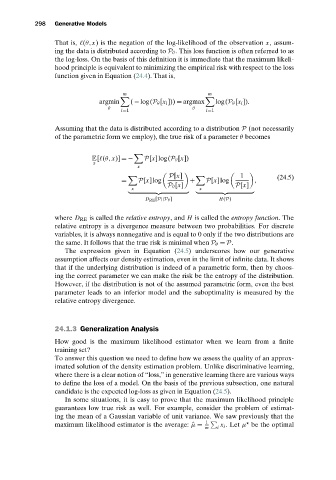Page 316 - Understanding Machine Learning
P. 316
Generative Models
298
That is, (θ,x) is the negation of the log-likelihood of the observation x, assum-
ing the data is distributed according to P θ . This loss function is often referred to as
the log-loss. On the basis of this definition it is immediate that the maximum likeli-
hood principle is equivalent to minimizing the empirical risk with respect to the loss
function given in Equation (24.4). That is,
m m
argmin ( − log(P θ [x i ])) = argmax log(P θ [x i ]).
θ θ
i=1 i=1
Assuming that the data is distributed according to a distribution P (not necessarily
of the parametric form we employ), the true risk of a parameter θ becomes
E[ (θ,x)] =− P[x]log(P θ [x])
x
x
P[x] 1 (24.5)
= P[x]log + P[x]log ,
P θ [x] P[x]
x x
9 :; < 9 :; <
D RE [P||P θ ] H(P)
where D RE is called the relative entropy,and H is called the entropy function.The
relative entropy is a divergence measure between two probabilities. For discrete
variables, it is always nonnegative and is equal to 0 only if the two distributions are
the same. It follows that the true risk is minimal when P θ = P.
The expression given in Equation (24.5) underscores how our generative
assumption affects our density estimation, even in the limit of infinite data. It shows
that if the underlying distribution is indeed of a parametric form, then by choos-
ing the correct parameter we can make the risk be the entropy of the distribution.
However, if the distribution is not of the assumed parametric form, even the best
parameter leads to an inferior model and the suboptimality is measured by the
relative entropy divergence.
24.1.3 Generalization Analysis
How good is the maximum likelihood estimator when we learn from a finite
training set?
To answer this question we need to define how we assess the quality of an approx-
imated solution of the density estimation problem. Unlike discriminative learning,
where there is a clear notion of “loss,” in generative learning there are various ways
to define the loss of a model. On the basis of the previous subsection, one natural
candidate is the expected log-loss as given in Equation (24.5).
In some situations, it is easy to prove that the maximum likelihood principle
guarantees low true risk as well. For example, consider the problem of estimat-
ing the mean of a Gaussian variable of unit variance. We saw previously that the
1
maximum likelihood estimator is the average: ˆµ = x i .Let µ be the optimal
m i

